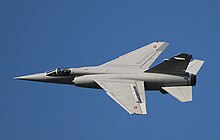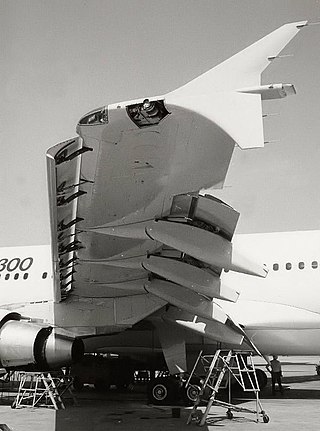This article needs additional citations for verification .(December 2007) |

In aeronautics, spoilerons (also known as spoiler ailerons or roll spoilers) are spoilers that can be used asymmetrically as flight control surfaces to provide roll control.
This article needs additional citations for verification .(December 2007) |

In aeronautics, spoilerons (also known as spoiler ailerons or roll spoilers) are spoilers that can be used asymmetrically as flight control surfaces to provide roll control.
Spoilerons roll an aircraft by reducing the lift of the downward-going wing. Unlike ailerons, spoilers do not increase the lift of the upward-going wing. A raised spoileron also increases the drag on the wing where it is deployed, causing the aircraft to yaw. Spoilerons can be used to assist ailerons or to replace them entirely, as in the B-52G which required an extra spoiler segment in place of ailerons present on other B-52 models. [1]
Spoilerons do not cause adverse yaw, unlike ailerons.
They are used in situations where aileron action would produce excessive wing twist on a very flexible wing or if wide-span flaps prevent adequate aileron roll control. [2]
They can also be used as spoilers.
The Mitsubishi MU-2 has double-slotted flaps that take-up the full length of the wing, to achieve good STOL performance. This leaves no room for ailerons, so it uses spoilerons instead.[ citation needed ]
Spoilerons can be used during a stall, whereas ailerons must not be used in a stall because they will have the opposite to intended effect.
Spoilerons reduce lift, increasing fuel usage. The lift reduction can be a problem in a one-engine-inoperative situation.

An early use of spoilers augmenting small ailerons, known as guide ailerons, was in the Northrop P-61 Black Widow night fighter. The spoilers allowed wider-span flaps for a lower landing speed. [3]
The B-52 Stratofortress also had spoilers augmenting small ailerons, known as feeler ailerons. These ailerons provided control forces to the pilot. The B-52G has no ailerons. The spoilers, situated inboard and forward of the trailing edge, are used for lateral control at high speeds to prevent excessive wing twist. [4]
The Mitsubishi Diamond Jet, Beechjet, and Hawker 400 family of business aircraft incorporate full length spoilerons that also double as speed spoilers during flight and landing.[ citation needed ]
Another aircraft with full-length double-slotted flaps was the Wren 460. To go with large aileron deflections at low speeds [5] it had a set of five feathering drag plates ahead of each aileron to overcome adverse aileron yaw and decrease lift on the low wing. [6]
Boeing's line of jet airliners have flight spoilers which can act as roll spoilers. They are activated automatically when the control wheel is displaced more than 10 degrees. [7]
The Tupolev Tu-154 have fast-acting spoilers. They double as spoilerons that assist the ailerons when the pilot commands a high roll rate. These can be observed in operation when the pilot is fighting gusting crosswinds while landing.[ citation needed ]

A fixed-wing aircraft is a heavier-than-air flying machine, such as an airplane, which is capable of flight using aerodynamic lift. Fixed-wing aircraft are distinct from rotary-wing aircraft, and ornithopters. The wings of a fixed-wing aircraft are not necessarily rigid; kites, hang gliders, variable-sweep wing aircraft, and airplanes that use wing morphing are all classified as fixed wing.

An aileron is a hinged flight control surface usually forming part of the trailing edge of each wing of a fixed-wing aircraft. Ailerons are used in pairs to control the aircraft in roll, which normally results in a change in flight path due to the tilting of the lift vector. Movement around this axis is called 'rolling' or 'banking'.

In fluid dynamics, a stall is a reduction in the lift coefficient generated by a foil as angle of attack increases. This occurs when the critical angle of attack of the foil is exceeded. The critical angle of attack is typically about 15°, but it may vary significantly depending on the fluid, foil, and Reynolds number.

Aircraft flight control surfaces are aerodynamic devices allowing a pilot to adjust and control the aircraft's flight attitude.

In aircraft design and aerospace engineering, a high-lift device is a component or mechanism on an aircraft's wing that increases the amount of lift produced by the wing. The device may be a fixed component, or a movable mechanism which is deployed when required. Common movable high-lift devices include wing flaps and slats. Fixed devices include leading-edge slots, leading edge root extensions, and boundary layer control systems.

In aeronautics, a spoiler is a device which intentionally reduces the lift component of an airfoil in a controlled way. Most often, spoilers are plates on the top surface of a wing that can be extended upward into the airflow to spoil the streamline flow. By so doing, the spoiler creates a controlled stall over the portion of the wing behind it, greatly reducing the lift of that wing section. Spoilers differ from airbrakes in that airbrakes are designed to increase drag without disrupting the lift distribution across the wing span, while spoilers disrupt the lift distribution as well as increasing drag.

A slip is an aerodynamic state where an aircraft is moving somewhat sideways as well as forward relative to the oncoming airflow or relative wind. In other words, for a conventional aircraft, the nose will be pointing in the opposite direction to the bank of the wing(s). The aircraft is not in coordinated flight and therefore is flying inefficiently.

A stabilator is a fully movable aircraft horizontal stabilizer. It serves the usual functions of longitudinal stability, control and stick force requirements otherwise performed by the separate parts of a conventional horizontal stabilizer and elevator. Apart from reduced drag, particularly at high Mach numbers, it is a useful device for changing the aircraft balance within wide limits, and for reducing stick forces.

A flap is a high-lift device used to reduce the stalling speed of an aircraft wing at a given weight. Flaps are usually mounted on the wing trailing edges of a fixed-wing aircraft. Flaps are used to reduce the take-off distance and the landing distance. Flaps also cause an increase in drag so they are retracted when not needed.

Dutch roll is an aircraft motion consisting of an out-of-phase combination of "tail-wagging" (yaw) and rocking from side to side (roll). This yaw-roll coupling is one of the basic flight dynamic modes. This motion is normally well damped in most light aircraft, though some aircraft with well-damped Dutch roll modes can experience a degradation in damping as airspeed decreases and altitude increases. Dutch roll stability can be artificially increased by the installation of a yaw damper. Wings placed well above the center of gravity, swept wings, and dihedral wings tend to increase the roll restoring force, and therefore increase the Dutch roll tendencies; this is why high-winged aircraft often are slightly anhedral, and transport-category swept-wing aircraft are equipped with yaw dampers. A similar phenomenon can happen in a trailer pulled by a car.
Aircraft flight mechanics are relevant to fixed wing and rotary wing (helicopters) aircraft. An aeroplane, is defined in ICAO Document 9110 as, "a power-driven heavier than air aircraft, deriving its lift chiefly from aerodynamic reactions on surface which remain fixed under given conditions of flight".

The Wren 460 is a STOL conversion of a Cessna 180 or 182 airframe.

Mach tuck is an aerodynamic effect whereby the nose of an aircraft tends to pitch downward as the airflow around the wing reaches supersonic speeds. This diving tendency is also known as tuck under. The aircraft will first experience this effect at significantly below Mach 1.

An aircraft stabilizer is an aerodynamic surface, typically including one or more movable control surfaces, that provides longitudinal (pitch) and/or directional (yaw) stability and control. A stabilizer can feature a fixed or adjustable structure on which any movable control surfaces are hinged, or it can itself be a fully movable surface such as a stabilator. Depending on the context, "stabilizer" may sometimes describe only the front part of the overall surface.
Adverse yaw is the natural and undesirable tendency for an aircraft to yaw in the opposite direction of a roll. It is caused by the difference in lift and drag of each wing. The effect can be greatly minimized with ailerons deliberately designed to create drag when deflected upward and/or mechanisms which automatically apply some amount of coordinated rudder. As the major causes of adverse yaw vary with lift, any fixed-ratio mechanism will fail to fully solve the problem across all flight conditions and thus any manually operated aircraft will require some amount of rudder input from the pilot in order to maintain coordinated flight.

In aerodynamics, pitch-up is an uncommanded nose-upwards rotation of an aircraft. It is an undesirable characteristic that has been observed mostly in experimental swept-wing aircraft at high subsonic Mach numbers or high angle of attack.

An aircraft in flight is free to rotate in three dimensions: yaw, nose left or right about an axis running up and down; pitch, nose up or down about an axis running from wing to wing; and roll, rotation about an axis running from nose to tail. The axes are alternatively designated as vertical, lateral, and longitudinal respectively. These axes move with the vehicle and rotate relative to the Earth along with the craft. These definitions were analogously applied to spacecraft when the first crewed spacecraft were designed in the late 1950s.

TWA Flight 841 was a scheduled passenger flight from John F. Kennedy International Airport in New York City, en route to Minneapolis-Saint Paul International Airport in Minneapolis, Minnesota. On April 4, 1979, at or around 9:48 p.m. Eastern Standard Time, while flying over Saginaw, Michigan, the Boeing 727-31 airliner began a sharp, uncommanded roll to the right, and subsequently went into a spiral dive. The pilots were able to regain control of the aircraft and made a successful emergency landing at Detroit Metropolitan Airport.
Otto C. Koppen was an American aircraft engineer.
The NRC tailless glider, also called the NRL tailless glider, was a two-seat tailless research glider designed by the National Research Council of Canada and built by the National Research Laboratories, at the instigation of G.T.R. Hill who had previously designed the British Westland-Hill Pterodactyl series of tailless aircraft.
{{cite web}}: CS1 maint: archived copy as title (link)